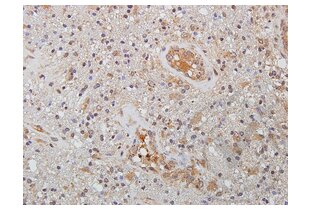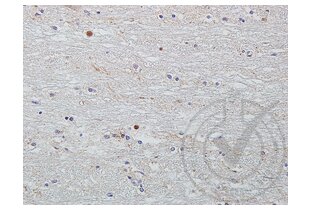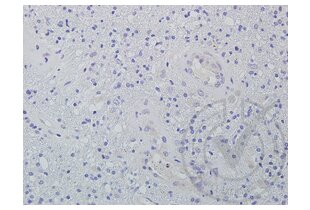WNT2 anticorps (AA 221-320)
-
- Antigène Voir toutes WNT2 Anticorps
- WNT2 (Wingless-Type MMTV Integration Site Family Member 2 (WNT2))
-
Épitope
- AA 221-320
-
Reactivité
- Humain, Souris
-
Hôte
- Lapin
-
Clonalité
- Polyclonal
-
Conjugué
- Cet anticorp WNT2 est non-conjugé
-
Application
- Western Blotting (WB), ELISA
- Réactivité croisée
- Humain, Souris
- Purification
- Purified by Protein A.
- Immunogène
- KLH conjugated synthetic peptide derived from human WNT2
- Isotype
- IgG
-
-
- Indications d'application
-
WB 1:300-5000
ELISA 1:500-1000
IHC-P 1:200-400
IHC-F 1:100-500
IF(IHC-P) 1:50-200
IF(IHC-F) 1:50-200
IF(ICC) 1:50-200 - Restrictions
- For Research Use only
-
- by
- Histopathology and Tissue Shared Resource, Georgetown Lombardi Comprehensive Cancer Center
- No.
- #029629
- Date
- 16.03.2014
- Antigène
- Numéro du lot
- 131105
- Application validée
- Immunohistochemistry
- Contrôle positif
- Human glioma tissue
- Contrôle négative
- Human brain
- Conclusion
- Signal was detected in positive control tissue and not in negative control tissue.
- Anticorps primaire
- Antigen: Wingless-Type MMTV Integration Site Family Member 2 (WNT2) (N-Term)
- Catalog number: ABIN762896
- Lot number: 131105
- Anticorps secondaire
- Antibody: Envision Plus Horse Radish Peroxidase conjugated anti-rabbit antibody
- Batch number: 10082183
- Full Protocol
- Immunohistochemistry was performed by hand.
- Sections were de-paraffinized on a Leica Autostainer in Xylenes (1X 5 min, 2X 2 min), and rehydrated through Ethanols (2X 100% for 5 min each, 95% 2X 2 min each, 80%, 70%) to running tap water. - Sections were heated to 98°C for 20 min in 10 mM Sodium Citrate buffer pH 6.0 for antigen retrieval, then moved to RT in the same buffer for 20 min.
- Sections were rinsed in de-ionized water for 5 min at RT.
- Sections were blocked in Hydrogen Peroxide (Fisher, H325-500) for 30 min at RT.
- Sections were rinsed in Tris Buffered Saline with 0.5% Tween-20 (TBST) 2 times for 5 min at RT.
- Sections were blocked in 5% Normal Goat Serum for 2 h at RT.
- Sections were incubated with primary antibody diluted 1:250 in TBST overnight at 4°C.
- Sections were rinsed in TBST for 5 min 2X at RT.
- Sections were incubated with Envision Plus anti-Rabbit-Horse Radish Peroxidase conjugated Polymer for 2 h at RT.
- Sections were rinsed in TBST for 5 min 2X at RT.
- Sections were incubated with DAB chromogenic substrate (DAKO, K348) for 10 min at RT.
- Sections were washed x 1 in Distilled Water.
- Sections were counterstained with 1:9 dilution of Harris Hematoxylin (Fisher, SH30-500D) for 2 min.
- Sections were washed x 1 in Distilled Water.
- Sections were blued in Ammonium Hydroxide for 1 min.
- Sections were washed x 1 in Distilled Water.
- Sections were dehydrated through graded alcohols, mounted in Acrymount and photographed on an Olympus DX61 microscope with DP70 camera using DP Controller and DP Manager Software.
- Notes
- The company recommends between 1:100 – 1:500 dilution factor; in our hands, 1:250 was overstained and we would recommend using a lower concentration of the antibody.
- The “normal” brain section we used proved to be from an individual who had morphological features of Parkinson’s Disease. The area shown in Figure 2 is from the morphologically normal part of the brain. The area with Parkinson’s morphology reacted strongly with the anti-wnt2 antibody (Figure 5).
Validation #029629 (Immunohistochemistry)![Testé avec succès 'Independent Validation' signe]()
![Testé avec succès 'Independent Validation' signe]() Validation ImagesProtocole
Validation ImagesProtocole -
- Format
- Liquid
- Concentration
- 1 μg/μL
- Buffer
- 0.01M TBS( pH 7.4) with 1 % BSA, 0.02 % Proclin300 and 50 % Glycerol.
- Agent conservateur
- ProClin
- Précaution d'utilisation
- This product contains ProClin: a POISONOUS AND HAZARDOUS SUBSTANCE, which should be handled by trained staff only.
- Stock
- 4 °C,-20 °C
- Stockage commentaire
- Shipped at 4°C. Store at -20°C for one year. Avoid repeated freeze/thaw cycles.
- Date de péremption
- 12 months
-
-
: "Macrophages mediate a switch between canonical and non-canonical Wnt pathways in canine mammary tumors." dans: PLoS ONE, Vol. 9, Issue 1, pp. e83995, (2014) (PubMed).
-
: "Macrophages mediate a switch between canonical and non-canonical Wnt pathways in canine mammary tumors." dans: PLoS ONE, Vol. 9, Issue 1, pp. e83995, (2014) (PubMed).
-
- Antigène
- WNT2 (Wingless-Type MMTV Integration Site Family Member 2 (WNT2))
- Autre désignation
- WNT2 (WNT2 Produits)
- Synonymes
- anticorps CG1916, anticorps D-wnt-2, anticorps DWnt-2, anticorps DWnt2, anticorps Dm DWnt2, anticorps Dm-2, anticorps Dmel\\CG1916, anticorps Dwnt-2, anticorps Wnt, anticorps Wnt-2, anticorps dWnt2, anticorps wnt2, anticorps WNT2, anticorps irp, anticorps Xwnt2, anticorps wnt-2, anticorps Xwnt-2, anticorps int1l1, anticorps 2610510E18Rik, anticorps Int1l1, anticorps Irp, anticorps Mirp, anticorps Wnt2a, anticorps INT1L1, anticorps IRP, anticorps ZfWnt2, anticorps Wnt oncogene analog 2, anticorps Wnt family member 2, anticorps wingless-type MMTV integration site family member 2, anticorps wingless-type MMTV integration site family, member 2, anticorps Wnt2, anticorps wnt2, anticorps WNT2
- Sujet
-
Synonyms: IRP, INT1L1, Protein Wnt-2, Int-1-like protein 1, Int-1-related protein, WNT2
Background: Ligand for members of the frizzled family of seven transmembrane receptors. Probable developmental protein. May be a signaling molecule which affects the development of discrete regions of tissues. Is likely to signal over only few cell diameters.
- ID gène
- 7472
- UniProt
- P09544
- Pathways
- Signalisation WNT
-






 (1 reference)
(1 reference) (1 validation)
(1 validation)



